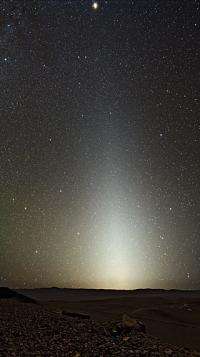Is the Earth a cosmic feather-duster?

Scientists at the University of Leeds are looking to discover how dust particles in the solar system interact with the Earth's atmosphere.
Currently, estimates of the Earth's intake of space dust vary from around five tonnes to as much as 300 tonnes every day. A €2.5 million international project, led by Professor John Plane from the University's School of Chemistry, will seek to address this discrepancy.
The Cosmic Dust in the Terrestrial Atmosphere (CODITA) project will investigate what happens to the dust from its origin in the outer solar system all the way to the earth's surface. The work, funded by the European Research Council, will also explore whether cosmic dust has a role in the Earth's climate and how it interacts with the ozone layer in the stratosphere.
"People tend to think space is completely empty, but if all the dust between the Sun and Jupiter was compressed it would create a moon 16 miles across. It's surprising that we aren't more certain how much of this comes to Earth" said Professor Plane.
"If the dust input is around 300 tonnes per day, then the particles are being transported down through the atmosphere considerably faster than generally believed; if the 5-tonne figure is correct, we will need to revise substantially our understanding of how dust evolves in the Solar System and is transported from the edge of space around 50 miles high to the surface," added Professor Plane.
Over the next five years, the scientists at Leeds, and visiting colleagues from Germany and the United States, will replicate in the laboratory the chemical processes that dust particles undergo as they enter and filter through the atmosphere.
"Our work in the lab will look at the nature of cosmic dust evaporation and the formation of meteoric smoke particles, which play a role in ice nucleation and the freezing of polar stratospheric clouds," said Professor Plane.
In the atmosphere, the dust particles undergo very rapid heating through collisions with air molecules, reaching temperatures well in excess of 1600 degrees Celsius. At this point they melt and evaporate. The larger particles can be seen as "shooting stars", whilst the electrons produced from ionizing collisions with air enable smaller dust particles to be detected using specialist high-powered radar equipment.
By replicating this heating in the lab, it is hoped that radar measurements of meteors can be better understood and used to make accurate measurements of the dust input. The metallic vapours recondense in the atmosphere to form nanometre-sized particles known as meteor smoke. In 2014, the team will be involved in a Norwegian rocket experiment to measure meteor smoke in ice particles in the upper atmosphere.
"Cosmic dust and meteor smoke are both believed to interact with the clouds which play a key role in causing stratospheric ozone depletion - most notably the formation of the Antarctic Ozone Hole," said Professor Martyn Chipperfield, from the University's School of Earth and Environment.
"We will use the lab data in a detailed chemistry-climate model of the whole atmosphere. This will make it possible, for the first time, to model the effects of cosmic dust consistently from the outer reaches of the Solar System all the way down to the Earth's surface," said Professor Chipperfield.
"It has been suggested that to combat global warming sulphate aerosol could be released into the atmosphere to reflect some of the Sun's heat. Understanding the quantity of cosmic dust and the potential chemical reactions which may occur is crucial to moving this idea forward," said Professor Chipperfield.
CODITA is funded by the European Research Council (ERC). The climate model which will be used in the project is supported at Leeds by the Natural Environment Research Council (NERC), and is a flagship model produced by the US National Center for Atmospheric Research (NCAR).
Provided by University of Leeds





















